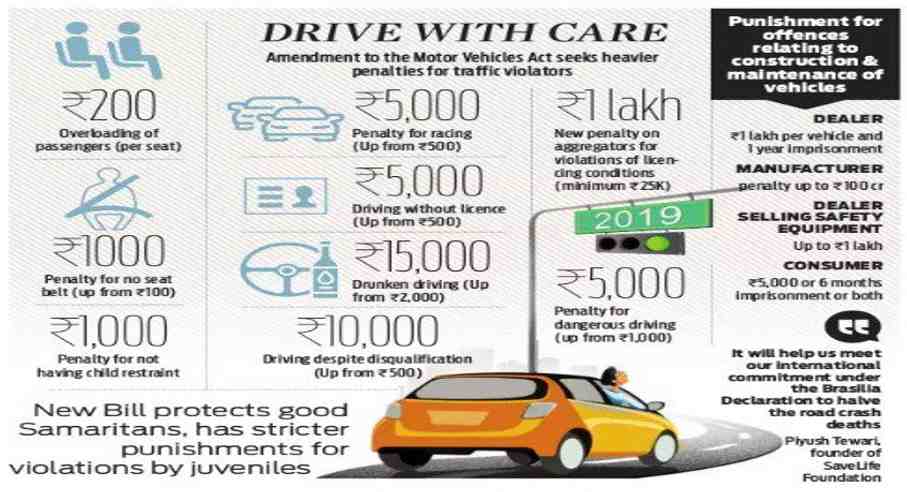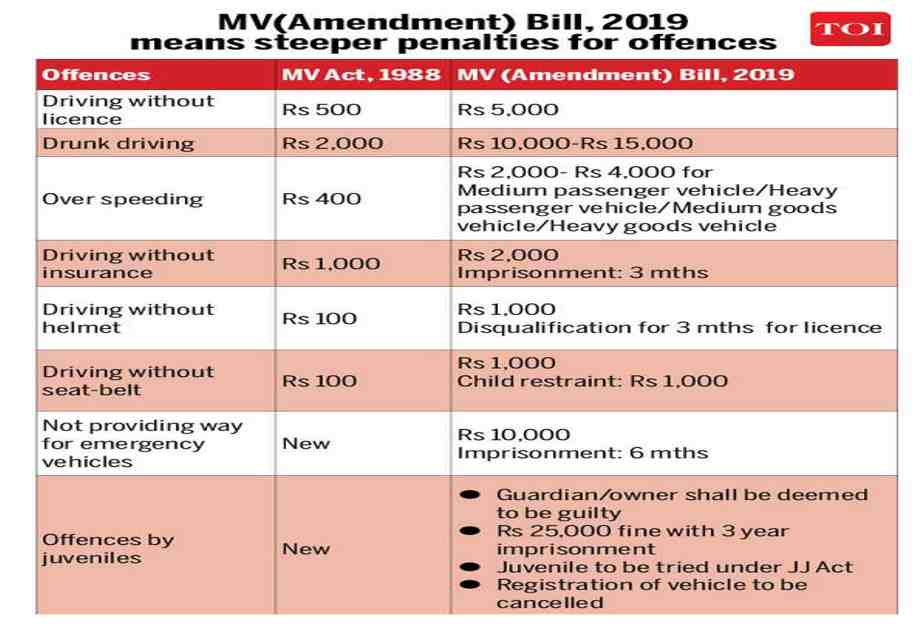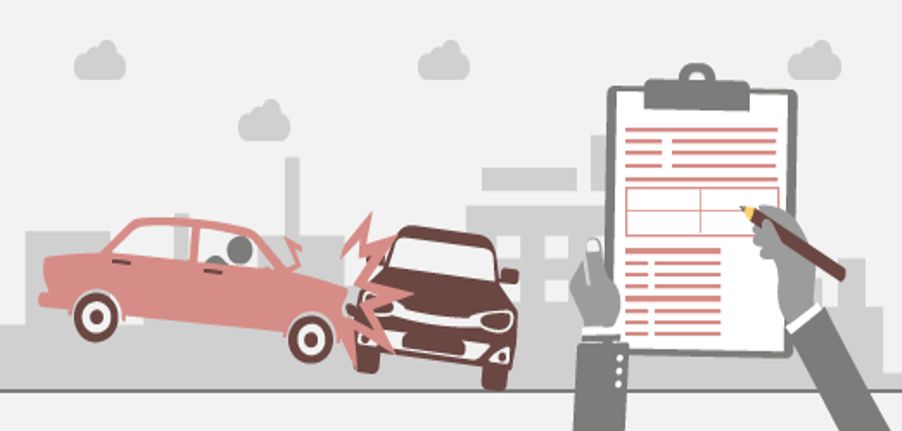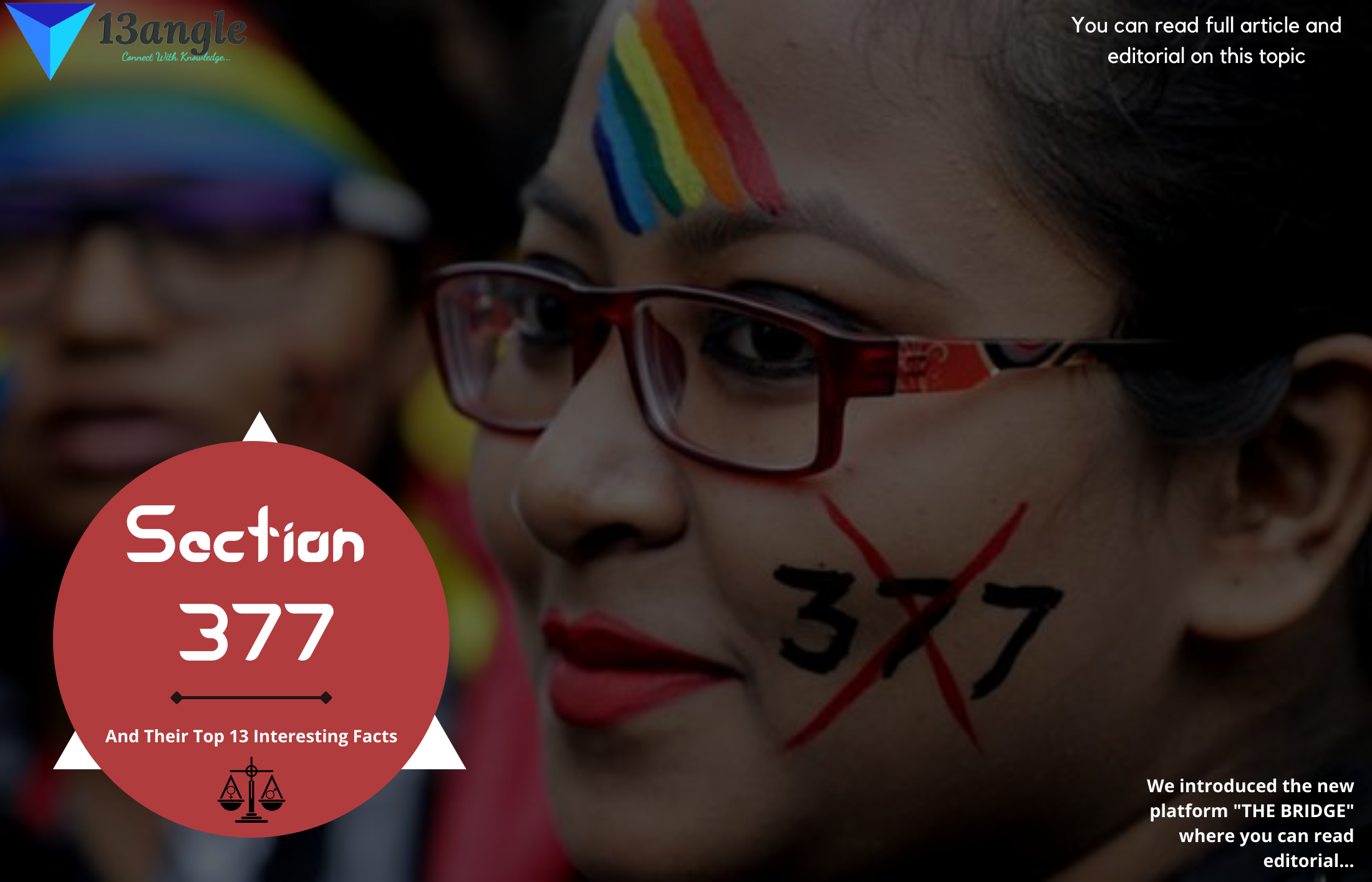
Introduction
- As we humans desire many things one of them is to own a vehicle due to the raise in the financial conditions of people it is not difficult to own a vehicle as also the road facilities are also increased. With the growing urbanization and rising incomes of the people, the number of uses of vehicles in India is increasing steadily.

The increase in the use of vehicles on the roads also led to an increase in the road accident rate. According to statistics, around 1.5 lakh people lost their lives because of road accidents; more are severely injured and lost their livelihood, and some become victims of road accidents.
Example: Raju a 25-year-old going to the office at 40 km/hr. on his bike at 8.30 am.
He was wearing a helmet; he took left by giving a signal suddenly a person who is talking on the phone in a rush dashed Raju. Raju fell and broke his hand and the person got scratches on his hand and leg only. So, in this case, Raju can get compensation by filing a case on that person under Motor Vehicle Act, this Motor Vehicle Act i.e., the motor vehicles Act deals with this type of case.
What Is The Motor Vehicle Act?
- The motor vehicle act is passed in the year 1988 by the Indian parliament. The act deals with all types of issues that occur through road transport modes. This act includes registrations of vehicles, insurance of vehicles, driving licenses, traffic regulations, permits and penalties.
Aim And No. Of Sections In The Act
- The main aim of the act is to reduce hit-and-run cases and to provide compensation to the victims. The growing use of vehicles in India needs registration of motor vehicles under this Act. Strict procedures to grant proper licenses to the citizens. To reduce time-consuming traffic by maintaining proper traffic. The number of sections in the Act is 217 and 14 chapters and 2 schedules.
Some of the important sections in the act are:
Section 3 of the Act deals with driving licenses i.e., a person without having a driving license cannot drive in public unless they have a valid and authorized driving license.
Section 4 of the Act deals with age limitations i.e., a person under the age of 18 years cannot drive in the public. whereas they can drive a vehicle below 50 cc when they reach the age of 16. No one under the age of 20 cannot drive a public transportation vehicle.
Section 9 deals with the Grant of a driving license.
Section 39 deals with the Necessity for registration- It says that no person can drive the vehicle in the public and even the owner of the vehicle also, without the registration of the vehicle.
Sections 40 and 41 deal with where the registration is made and how to make registration.
Section 59 deals with the power to fix the age limit of the motor vehicle- The central government, regarding public safety and convenience of the act, specifies the life of the motor vehicle from the date of its manufacture. The govt specifies the different times for different motor vehicles based on their types.
Section 66 deals with the Necessity for permits- The owner of the vehicle cannot operate the vehicle in any public area without valid Authorization.
Section 109 deals with General provisions regarding the construction and maintenance of vehicles.
Section 112 deals with Limits of speed- No person shall drive a motor vehicle or cause or allow a motor vehicle to be driven in any public place at a speed exceeding the maximum speed or below the minimum speed fixed for the vehicle by the Act or by or under any other law for the time being in force.
Section 129 deals with wearing protective headgear- Every person who is driving or riding, shall while in a public place, wear protective headgear conforming to the standards of the Bureau of Indian standards. There is an exception for the Sikh person who is wearing a turban while driving in a public place. Protective headgear here means “helmet”.
Section 130 It is the duty of the person i.e., driver of the respected vehicle to produce the license and certificate of registration to the officer in uniform when he asks for examination.
Section 140 deals with the Liability to pay compensation in certain cases on the principle of no fault. The compensation is as follows Death of a person 50,000 Permanent disablement 25,000.
Section 163A deals with special provisions as to payment of compensation on a structured formula basis- The owner of the vehicle is liable if any accident is done by that vehicle, and the owner of the vehicle must pay compensation to the victims or to the legal heirs of the victim in the case of death or permanent disablement. The claimant does not have to prove or plead.
Section 166 deals with the Application for compensation. An application for compensation may be filed by;
- By the person who has sustained the injury; or
- By the owner of the property: or
- Where death has resulted from the accident, then by all or any of the legal representatives of the deceased
- Any agent duly authorized by the injured person or all or any legal representative of a deceased person.
Section 177 deals with the General provision for the punishment of offences- For any person who violates the rules fine is imposed on the person up to 500 rupees for the first time and then repeated then extend up to 1000 rupees.
Section 179 deals with Disobedience of orders, obstruction and refusal of information. Any person who disobeys the orders given lawful authority or withholds the information shall be liable to impose a fine of up to 2,000 thousand rupees and one month in jail or both.
Section 184 deals with Driving Dangerously- Any person who is driving dangerously in public shall be liable for imprisonment of 6 months or 1,000 or both for the first time. For any second or subsequent offence if committed within the 3 years of the commission of a similar offence with imprisonment of a term which may extend to 2 years or a 10,000 fine or both.
Section 185 deals with Driving by a drunken person or by a person under the influence of drugs- Any person who is driving or attempting to drive a motor vehicle who is having alcohol in his blood exceeding 30mg per 100ml of blood detected in a test by breath analyzer or any other laboratory test. If and is under the influence of a drug to such an extent as to be incapable of exercising proper control over the vehicle is liable for imprisonment which may extend to 6 months or a 10,000 fine or both for the first time, if the same offence is committed for a second or subsequent time, imprisonment for a term which may extend to 2 years or fine of 15,000 rupees or both.
New Amendments To The Motor Vehicle Act,1988
- The Amendments made to the motor vehicle Act, of 1988 are 2 one of them made in 2019 and another in 2022. Both the Amendments deal with third-party insurance and claims management, vehicle safety, road safety, and including filing claims with motor accident claims tribunals.
The Amendments made in 2019 are as follows:
- The motor vehicle (Amendment) Act 2019 was introduced by Nitin Gadkari on 15 July 2019 Lok Sabha, the then transport minister.

The aim of the Act is to bring changes in the fines charged for various traffic offences and compensation to the victims’ families and ensure Strictly to all people follow safety measures.
The fines are also imposed on the People.

The salient features of the Act are;
1. Road safety: The proposes to increase the penalties for traffic violations so that the violation rate will decrease. It includes strict actions for juvenile driving, racing, driving without a license, and racing, etc. And, strict actions for driving motor vehicles without wearing a helmet.
2. Compensation for road accident victims: The central govt will develop a scheme such as golden hour for the treatment of victims within one hour of the accident occurring so that threat of death decreases.
3. Vehicle fitness: By this, the vehicles are tested and checked whether they are in good condition or not. This increases road safety and removes the unfit vehicles
4. Road Safety Board: The Motor Vehicle (Amendment) Act,2019 provides for the setting up of the National Road Safety Board by the central government. It will advise the central and state Boards on road safety and traffic management includes
- Registration and licensing of vehicles.
- Standards of motor vehicles.
- Promotion of new vehicle technology.
- Standards for road safety.
5. Protection of Good Samaritans: The Bill includes guidelines for the Good Samaritans to help road accident victims. The good Samaritan is the person who helps to road accident victims during their need for medical help or assistance they need at that time. The person is not liable for any criminal or civil action for the injury to or death of the road accident victim, caused due to their negligence in aiding the victim.
MORTH (Ministry Of Road Transport And Highways)
- The MORTH has made some changes to the Motor Vehicles Act, of 1988 which will come into effect from Oct 1, 2020. They made these changes for the implementation of traffic rules, to promote digitalization, and prevent the hurdles faced by everyday road travelers.
1. Online documents:
- we can save documents like driving licenses etc. online so no need to carry physical documents. If policemen ask, we can present soft copies.
2. E-challan:
- Any person who violates the traffic rules will be issued an online E- challan through the government digital portal.
3. Use of phones:
- It can use phones for route navigation by making sure that the driver’s concentration is intact while driving.
- Certificates like driving licenses or registration can be saved on online government websites like Digi- locker or m- parivahan.
The Amendments made in 2022 are:
- Omissions under chapter 10 of the Motor vehicle Act, 1988: Provisions of interim compensation, that come under no-fault liability i.e., sections 140 to 144 are omitted and no other interim compensation has been made available in the motor accident claims.
- The “no-fault liability” compensation is set 1)
1) 2 lakhs-death.
2) 50 thousand-grievous injuries.
Also, it is no longer required to prove the negligence of the driver.
Replacement of chapter 11:
- Insurance provisions for motor vehicles relating to third-party risks i.e., sections 145 to 164 were replaced with new provisions as under sections 145 to 164D. They are as follows;
- Section 149 (1) Designated officer to be appointed by the insurance firm within 10 days of the accident.
- Section 149 (2) Insurance firm’s settlement officer. Section 149 (3) (a) Award of consent by claims tribunal.
- Section 149 (3) (b) Rejection of settlement offered by claimant.
- Section 150 Satisfaction of Award or judgment against persons insured under third-party risks is the responsibility of the insuring firm.
- Section 156 The insurance firm cannot refuse a claim after the death of the insured in the accident.
- Section 158 (1) All documents relating to the vehicle’s use Shall be duly presented by the driver.
- Section 158 (2) All documents relating to the accident to be produced are the
- owner’s responsibility.
- Section 159 Accident Information Report to be filed at the claims Tribunal within three months by the police officers.
- Section 160 Furnishing accidental vehicles to the claimants is the responsibility of the Police Officers and Registering Authority.
- Section 161 Increase in hit-and-run compensation. Section 162 Golden Hour scheme.
- Section 164 No-Fault Liability-related compensations.
- Section 164 (A) Scheme-making powers to grant interim relief. Section 164 (B) Funds for Motor Vehicle Accidents.
- Section 164C Rule Making Power of Central Government. Section 166(3) Compensation making limitations.
- Section 166(5) After the demise of the injured, the legal representatives are permitted to continue the claim.
- Section 173(2) If the award of claims is less than INR 1,00,000/ no appeals are permitted.
Date Of Commencement
- The Amendments made to the Motor Vehicle Act, of 1988 are;
- The Motor Vehicle (Amendment) Act,2019 came into effect on 1st September 2019.
- The Amendment made in 2022 came into effect on 1st April 2022.
Changes In The Fines Present In The New Motor Vehicle Act
The changes in the fines present in the new i.e., Amended Motor Vehicle Act, 1988 are as follows;

Accident Claims Under The Motor Vehicle Act
A person injured in a motor accident or legal representatives of the person deceased in a motor accident can apply for compensation under the Motor Vehicle Act, of 1988. It is an act to prevent accidents and if they occurred to provide adequate compensation to victims by the wrongdoers.
- The Act regulates all the cases related to motor accidents all over India. The government established the Motor Appellate Claim Tribunals to handle motor accident Claim cases.
SECTION 166 of the Act talks about who can claim compensation in Motor Accident Claims Tribunal.
Who can claim compensation in MACT cases?
As per Section 166 of the Act, a person claims compensation if:
- he has sustained an injury
- he is the owner of the property
- he is the legal representative of the person who died in the motor accident.
- he is the agent authorized by the injured person, or by the legal representatives of the deceased, as the case may be
Where can compensation be claimed?
The application for the claim can be filed in the following tribunals:
- The Claims Tribunal where the claimant resides.
- The Claims Tribunal is where the owner of the vehicle resides.
- The Claims Tribunal where the accident took place.
Types Of Claims
There are 3 types of claims under which compensation can be claimed, they are;
No-Fault Liability- The liability is dealt with under section 140 of the act. In this the claimant has no need to prove the Fault of the other person or party, there is no joint liability. But the Liability arises only when there is death or permanent disability of the person.

The compensation the claimant can claim for Death- 50,000
Permanent disability- 25,000
HIT AND RUN- Section 161 of the Act deals with the claims made under Hit and Run cases. In this, the accused hits the victim with his and instead of helping him chooses to run away.
As per section 161 (3) Compensation is paid as follows:
Death- 25,000 is increased to 2lakhs.
Injured- 12,500 is increased to 50,000 rupees.
Structured Formula Basis
- The Motor Vehicles Act, of 1988 was amended in the year 1994. This amendment introduced a new section of the Act i.e., Section 163 A. According to this section a claimant does not need to prove the fault of the driver. The owner (defined under Section 2(30) of the Motor Vehicles Act, 1988) or the insurer must compensate the claimant, but on the condition that the identity of the accused must be revealed. Also, there is another condition under which the claimant can file a complaint under Section 140 or Section 163 A. If his complainant has already been granted compensation under Section 140 then under this section, he will only get the balancing amount.
Use Of The Act In India; Positives And Negatives
1. POSITIVES:-
- Vehicle fitness.
- Recall of vehicles.
- Third-party insurance.
- Road Safety Board.
- Protection of good Samaritan.
- Online driving license.
- Motor vehicle accident fund.
- Process of vehicle registration.
- National Register for Driving license & Vehicle Registration.
- Better insurance facilities.
- National Transportation Policy Compensation for Victims of road accidents
- Road and Environment Health
2. NEGATIVES:-
As the act imposed heavy fines on the people it will be very hard for the common people to pay. As the government must provide proper roads as they are in bad condition accidents rate may increase. Before Imposing fines on the common people, the roads are to be in proper condition.
Conclusion
With the increase in the use of vehicles in the present-day pollution also increased. With the new Amendments made to the Act, the government reducing accidents and imposing heavy fines on traffic violators will help in following the traffic rules.
Providing online license and an increase in the compensation of road accident victims are the new reforms that will reduce the wastage of time of the common people and provides adequate compensation for the victims.
So, by this, we can say that introducing these new rules and Amendments to the act is helpful to the people.
Top 13 Facts Of The Motor Vehicle Act
The Motor Vehicle Act was first made in the year 1914 and then replaced by Motor Vehicle Act 1939 and then the motor vehicle Act 1988 came into existence. Though the Act was introduced in 1988 and came into effect on 1st July 1989.
The Act regulates all the aspects related to road transport like issuing the driving licence, traffic regulations, insurance of vehicles, registration of vehicles under the MOTOR VEHICLE Act and compensation to road accident victims etc. and many more.
Recently the Act was amended in 2019 and 2022 and introduced provisions regarding third-party insurance, claims management, increase in fines, increase in compensations for hit-and-run cases and filing claims with Motor Accident Claims Tribunal.
These amendments came into force on 1st Sept 2019 and 1st April 2022.
According to the new Act, Aadhar is now mandatory to obtain a driving licence and registration of the vehicle.
The Motor Vehicle (Amendment) Act 2019, increased fines to reduce traffic violations.
For example, i.e. using a mobile phone while driving as per the old Act 1,000 rupee fine as per the new act it is a 5,000 rupee fine.
The compensation for Hits and Run cases increased from in case of death 25,000 to 1 lakh in case of grievous injury 12,500 to 50,000 rupees.
Wearing of “protective headgear” i.e. helmet made compulsory under section 129 of the Act. In the case of not wearing a helmet during driving imposes a fine of 1,000 rupees along with the suspension of driving licence for 90 days.
According to the new Act, there is no need to carry physical documents. The documents like DL and registration certificates can be saved online in the government portals like Digi-locker and m-parivahan.
E-challan will be issued according to the new act to the person who violates the traffic rules and the same is happening repeatedly the DL of the person can be cancelled by a police officer through an online portal.
The Bill mandates the automatic fitness testing of the vehicle and allows the central government to order for recall of motor vehicles if there is any defect that may harmful to the environment.
The Bill provides ” Golden Hour ” which means cashless treatment to road accident victims during the first hour as it reduces the risk of death.
The main Aim of the act is, as there is an increase in the use of vehicles due to the development of the automotive sector so to reduce pollution and increase the standards for Road Safety.





